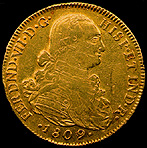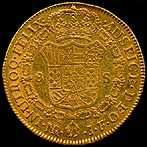Spanish Escudos
obverse |
|
reverse |
| |||
1/2 Escudo 1778 M-PJ Charles III (Madrid, Spain)
Obverse: CAROL · III · D · G · HISP · R · 1778 ·
Reverse: [no legend]
Weight: 27.5 g (1.78 grams) Diameter: 14.7 mm
Comments: The obverse bears a portrait of Charles III with an abbreviated form of the legend "Charles III by the grace of God King of Spain." Note the punch used for the number 8 in the date is open on the left side f the top part of the number. The reverse bears the crowned Spanish arms surrounded by a deoration of the Order of the Golden Fleece. The crowned M mintmark to the left of the arms indicates Madrid. To the right of the arms, the initials 'P' and 'J' refer to the assayers, Pedro Cano and Juan Bautista Sanfaury who worked together from either 1765 or 1772 through 1782 (see Pellicer i Bru, Glosario, pp. 33 [gives 1765] and 172 [gives 1772]). The half escudo (or half shield) was regularly produced in Spain from 1738 but was only briefly minted in Mexico 1814-20.
Provenance: From the Robert H. Gore, Jr. Numismatic Collection.
obverse |
|
reverse |
| |||
8 Escudos 1809 NR-JF Ferdinand VII Doubloon (Nuevo Reino, Bogotá, Columbia)
Obverse: FERDND · VII · D · G · HISP · ET IND · R · · 1809 ·
Reverse: IN · UTROQ · FELIX · · AUSPICE · DEO / · [NR monogram] · · J · F ·
Weight: 419.7 g (27.19 grams) Diameter: 37.8 mm
Comments: This coin is from the first year of the reign of Ferdinand VII and obverse bears a portrait of the previous king, Charles IV, with an abbreviated form of the legend "Ferdinand VII by the grace of God King of Spain and the Indes." The reverse bears the crowned Hapsburg arms surrounded by the order of the Golden Fleece. The '8' and 'S' which appear on either side of the arms indicate the denomination, 8 escudos. The 'NR' in the legend is the mintmark, indicating mintage in Nuevo Reino de Granada in Santa Fe de Bogotá, Columbia. Next is the pendent sheep skin from the decoration of the Order of the Golden Fleece. Then come the initials 'J' and 'F' indicating the assayers, José Antonio Rodríguez and Francisco Rodríguez who worked together from 1808-1810 (see Pellicer i Bru, Glosario, pp. 42 and 138). The legend lacks a verb but may be loosly translated as "Under the auspicies of God there is happiness on both sides." I take utroque to refer to both Old Spain and New Spain as it does on the colonial silver coinage. This is the largest of the Spanish colonial gold coins, referred to by the English colonists as a Spanish doubloon.
Provenance: From the Robert H. Gore, Jr. Numismatic Collection.
| Spanish Gold Ingots | Section Contents | Lion Dollar |
|
For viewing tips and information on optimal computer settings click
here.
For questions or comments contact Special Collections by: |



